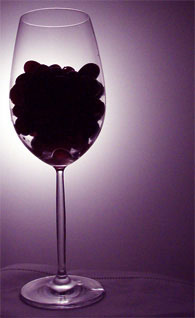The Ultimate Wine Snob
Did you hear the story about Gerald, the wine snob? Whilst walking the streets, he was struck a glancing blow by a presumptuous, wine-laden delivery. Besides his bruised ego, he acquired a small black and blue mark. But before Gerald could take down the truck's details, it disappeared around the corner with such haste that a few bottles of wine fell out to smash on the road. When Gerald reported the incident at the nearest police station, the duty Sergeant didn't know how he was going to find the offender. "So you saw nothing at all?" the policeman asked Gerald. "No, but I did get a whiff of the bouquet of the wine."

Faking It at the Party
Perhaps you don't really want to become a wine snob like Gerald. But when the occasion arises, knowing a bit about wine will certainly do wonders for your reputation. Here are some bluffer's tips to help you become a truly first-rate wine pretender.
Looks Matter - How to look the part of a wine connoisseur.
Looking the part is half the battle. Look around when you're at a party. See how everyone cradles their glass? That's a no-no. Real wine drinkers never hold or cradle the bowl.
Firstly, it leaves unsightly fingerprints on the crystal. More critically, hands warm wine that is supposed to be enjoyed at European room temperature of 18 Celsius (red wines) and cold at 10 Celsius (white wines). The correct way to hold the glass is by the stem - as shown.
Indeed, the French citizens who looked up to the late President Mitterrand as a cultured man were quick to note that when Mr. Chirac first stepped into the position, he could be seen in an official photos, cradling his wine glass.
However, there is a third reason why wine aficionados hold their glasses by the stem. By doing so, they are able to swirl the wine around to aerate the wine so that the aromas in the glass develop. Much about wine appreciation is about smelling the wines to enjoy its aromas or bouquet before tasting it and finally swallowing the wine.
Tip: Practice swirling the wine at home. Fill a glass half way and begin by swirling it with its base on the table, taking care no wine spills out. When you get better, you can do it in 'air' whilst standing up.
Winging it at the table
With a flourish, the bottle of wine is presented to you, soliciting some inquisitive glances from the diners at neighbouring tables. Inevitably, the conversation at your table pauses for an instant as all eyes turn to you, awaiting your comments on the wine. The stage is yours!
Method - Pick up the glass, lift it to the light and look at it. Swirl the glass around and stick your nose into it to take a sniff. Do this repeatedly for a few times before taking your first sip.
The Appearance or La Robe - Praising the clarity of the liquid is a start. Noting the depth of intensity shows your eye for colour. Young white wines will be light green, straw yellow or light golden. Young red wines will be a dark purple.

TIP: As a general guide, the vintage/year should be more than seven years old for the red and more than four years for the white for you to remark on its maturity of colour.
On encountering a murky or cloudy wine, immediately lift up the glass to the sommelier and look him straight in the eye. The bottle will be taken back and replaced with a new one; no questions asked.
The Nose or Le Nez (pronounced: le-nay) - In a young wine, the simple nose will be fruit driven. The young wine is then aromatic and desirable. If the wine reminds you of citrus fruits, peaches or tropical fruits in white wine; cherries or blackcurrants in red wine, you've done exceedingly well.
With fine, mature wines, you are on higher ground. The heavenly sought after 'bottle bouquet', detected as minerals, resin, figs, mushrooms, chocolates or musky scents should make you swoon with delight. Or at least look like it. Try not to overdo it or they might call for a paramedic.
TIP: Take your time and close your eyes as you sniff the wine repeatedly. After all, you are 'tasting' on behalf of your fellow diners and their anticipation of your pronouncement will add to the significance of what they will hear. Remember, praise the AROMA of youthful wine and commend the BOUQUET of mature wine.
The Palate or La Bouche (pronounced: la-boosh) - If you wish, making a show of gargling the wine will have you on par with the most experienced tasters. Not something to attempt in public if you have a strong gag reflex. Then again, that shouldn't really be a problem.
Comment on the exceptional taste if the wine has a silky texture with ample flavours that linger after swallowing. If you can't find anything praiseworthy, take the middle road. State that your preferences in wines are those that should not be too dry/tart/sour (aggressive) nor too sweet (flabby), not overly warm in sensation (vinous/alcoholic), and possess soft tannins that are not chewy (astringent) in texture like when you have strong tea.
It is virtuous to say that the intricate 'balance' of the elements of sugar, alcohol, acid and tannins in good wines distinguish them from the mediocre ones. Who would dare disagree with such a pronouncement?
Finally, the 'coup de grace'. Attribute gender to the wines. Robust, full-flavoured, or over-powering wines are masculine and virile. Floral, perfumed, elegant or light wines are alluring and sexy.
TIP: If you can't remember, most red wines are MASCULINE and most white wines are FEMININE.
